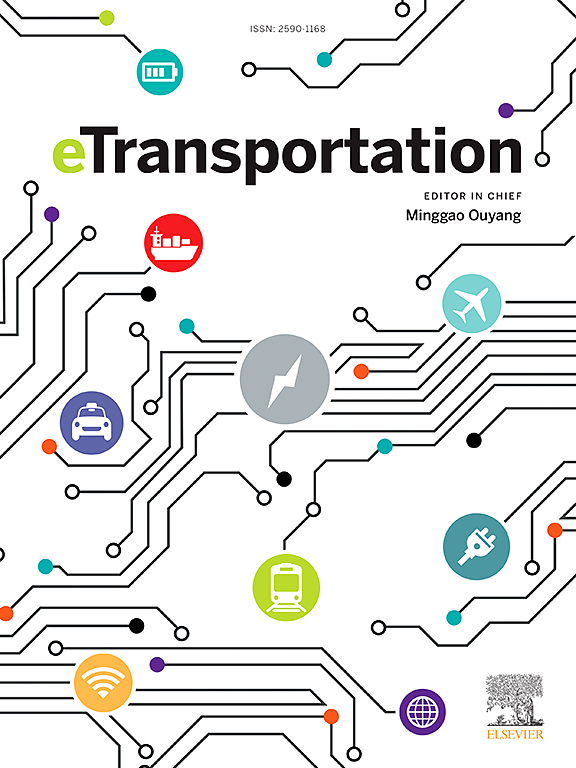基于模型预测控制的动态充电调度,最大化局部光伏剩余电量利用率
IF 17
1区 工程技术
Q1 ENERGY & FUELS
引用次数: 0
摘要
随着公共交通的电气化和可变可再生能源的采用加速了向碳中和的过渡,将当地光伏(PV)剩余电力整合到电动公交车充电操作中变得越来越重要。然而,光伏发电的不确定性和交通延迟往往会因错过充电机会而降低光伏剩余的有效利用。为了解决这些问题,本研究提出了一种基于模型预测控制(MPC)的动态充电调度方法,该方法利用准实时的区域尺度信息自适应更新充电调度。该框架集成了通用交通馈送规范格式(GTFS Realtime)的实时交通延迟、智能电表测量和气象卫星观测,这些数据源目前在实际城市中可用。在每个更新步骤中,系统使用机器学习模型预测光伏剩余电量,该模型捕获时间天气条件和充电站周围的局部光伏剩余趋势,同时检测每个充电站的公交车延误。基于这些信息,每30分钟更新一次最优充电计划,以自适应最大化光伏剩余利用率。一整年的数值模拟实验证明了该方法的有效性。与固定日前计划和基于规则的充电方式相比,该方案可将年平均光伏剩余利用率提高11.9%,将年平均电网购电量降低15.6%。这些结果突出了MPC与准实时、区域尺度数据相结合的潜力,可以在不确定的情况下主动、稳健地将可再生能源整合到公共电动巴士运营中。本文章由计算机程序翻译,如有差异,请以英文原文为准。

Dynamic bus charge scheduling by model predictive control to maximize local PV surplus power utilization
As the electrification of public transport and the adoption of variable renewable energy accelerate the transition to carbon neutrality, integrating local photovoltaic (PV) surplus power into electric bus charging operations becomes increasingly critical. However, uncertainties in PV generation and traffic delays often reduce the effective utilization of PV surplus due to missed charging opportunities. To address these challenges, this study proposes a dynamic charging scheduling method based on model predictive control (MPC), which adaptively updates the schedule using quasi-real-time, district-scale information. The framework integrates real-time traffic delays in the General Transit Feed Specification format (GTFS Realtime), smart meter measurements, and meteorological satellite observations—data sources currently available in real cities. At each update step, the system forecasts PV surplus power using a machine learning model that captures temporal weather conditions and localized PV surplus trends around charging stations, while detecting bus delays at each station. Based on this information, the optimal charging schedule is updated every 30 min to adaptively maximize PV surplus utilization. Numerical experiments simulating an entire year demonstrate the effectiveness of the proposed method. Compared to a fixed day-ahead schedule and a rule-based charging method, it improves the annual average PV surplus utilization rate by up to 11.9% and reduces annual average grid power purchases by up to 15.6%. These results highlight the potential of combining MPC with quasi-real-time, district-scale data to proactively and robustly integrate renewable energy into public electric bus operations under uncertainty.
求助全文
通过发布文献求助,成功后即可免费获取论文全文。
去求助
来源期刊

Etransportation
Engineering-Automotive Engineering
CiteScore
19.80
自引率
12.60%
发文量
57
审稿时长
39 days
期刊介绍:
eTransportation is a scholarly journal that aims to advance knowledge in the field of electric transportation. It focuses on all modes of transportation that utilize electricity as their primary source of energy, including electric vehicles, trains, ships, and aircraft. The journal covers all stages of research, development, and testing of new technologies, systems, and devices related to electrical transportation.
The journal welcomes the use of simulation and analysis tools at the system, transport, or device level. Its primary emphasis is on the study of the electrical and electronic aspects of transportation systems. However, it also considers research on mechanical parts or subsystems of vehicles if there is a clear interaction with electrical or electronic equipment.
Please note that this journal excludes other aspects such as sociological, political, regulatory, or environmental factors from its scope.
 求助内容:
求助内容: 应助结果提醒方式:
应助结果提醒方式:


